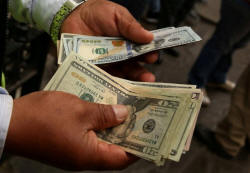Dollar heads toward six-month highs as trade war fears
rise
 Send a link to a friend
Send a link to a friend
 [June 05, 2018]
By Saikat Chatterjee [June 05, 2018]
By Saikat Chatterjee
LONDON (Reuters) - The dollar on Tuesday
edged toward a six-month high hit last week as the latest bout in a
trade war between the U.S. and its commercial partners prompted selling
in emerging market currencies, but gains were capped before a summit
this weekend.
Markets were also awaiting data that might confirm the U.S. economy is
on track for a strong June quarter, lifting Treasury yields as well as
giving the dollar an additional boost.
"I am surprised the latest round of trade tariffs hasn't fueled a bigger
drop in other currencies as this basically signals inflationary
pressures will rise in the U.S. and prompt the Fed to raise interest
rates more," Commerzbank FX strategist Esther Maria Reichelt said.
Against a basket of currencies <.DXY>, the dollar climbed 0.1 percent at
94.13. It hit 95.02 last week, its highest since early November 2017,
and has risen more than 5 percent since mid-April.

The Mexican peso <MXN=D3> and the Canadian dollar <CAD=D3> led losers
against the dollar as trade war concerns rose.
Mexico said it will impose a 20-percent tariff on U.S. pork imports
after U.S. President Donald Trump slapped tariffs on steel and aluminum.
The tariff was in response to the Trump administration's decision last
week to impose steel and aluminum tariffs on Mexican exporters on
grounds that countries including Mexico engage in competition damaging
to U.S. national security.
The U.S. decision to go ahead with the steel and aluminum tariffs has
complicated talks with Mexico and Canada to rework the North America
Free Trade Agreement (NAFTA). I
ING strategists said in a note the latest moves by Mexico might prompt
Trump to pull out of NAFTA altogether.
With correlations between short-dated U.S. bond yields and the dollar
strengthening to their strongest since January 2017, investors have
responded by buying the greenback in recent days, especially against the
euro and emerging market currencies.
Short-dated U.S. Treasury yields are up by about 20 basis points (bps)
in a week, pushing two-year government yields <US2YT=RR> to 2.50 percent
and within a whisker of a decade high of the 2.59 percent hit last
month.
"The dollar is perched around some important levels and its strength can
be judged from the fact that the euro/dollar has failed to break above
the $1.17 line despite falling Italian political concerns," Societe
Generale strategist Kenneth Broux said.
[to top of second column] |

A money changer holds U.S. dollar bills at a street in downtown
Lima, Peru, December 15, 2017. REUTERS/Mariana Bazo

EURO ZONE CONCERNS
The dollar's strength was also helped by the euro's lingering weakness
with latest headlines offering little evidence that Italy would stick to
a path of fiscal restraint.
Bond yields rose on Tuesday, after new Italian Prime Minister Guiseppe Conte
promised to bring radical change as he sought parliamentary backing for an
anti-establishment government.
The euro <EUR=EBS> was broadly flat at $1.16930. Since hitting a 10-month low of
$1.1510 a week ago, it has recovered somewhat as investors took comfort from the
formation of a coalition government in Rome.
However, market moves were muted before a Group of Seven summit starting on
Friday.
The June 8 to June 9 meeting in Canada will begin with a working session on
economic growth and trade - topical issues after Trump's imposing the steel and
aluminum tariffs.
Strong U.S. employment data published on Friday has revived bets that the
Federal Reserve will raise interest rates three more times this year. Market
expectations are for two further rate hikes before until December.
A strong reading on ISM non-manufacturing PMI for May later in the day might
seal the case for another rate hike at its policy meeting next week, following
up on a rate hike in March and might even prompt the Fed to take a hawkish
stance.
"The U.S. jobs data was really strong. The Fed could indicate it will raise
rates four times this year, including an expected hike in June and one in
March," Daiwa senior currency strategist Yukio Ishizuki said.

(Reporting by Saikat Chatterjee; Additional reporting by Hideyuki Sano in TOKYO;
Editing by Louise Ireland)
[© 2018 Thomson Reuters. All rights
reserved.] Copyright 2018 Reuters. All rights reserved. This material may not be published,
broadcast, rewritten or redistributed.
Thompson Reuters is solely responsible for this content. |